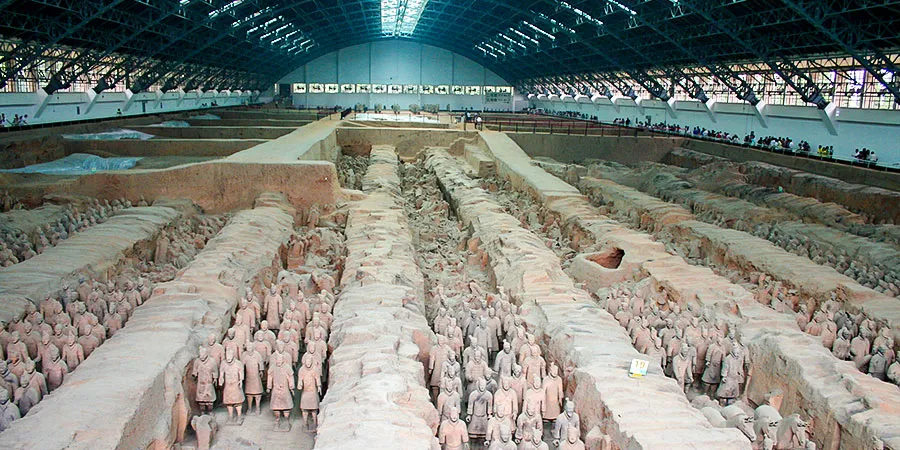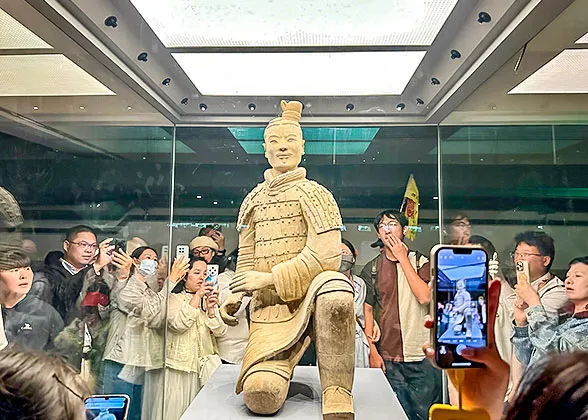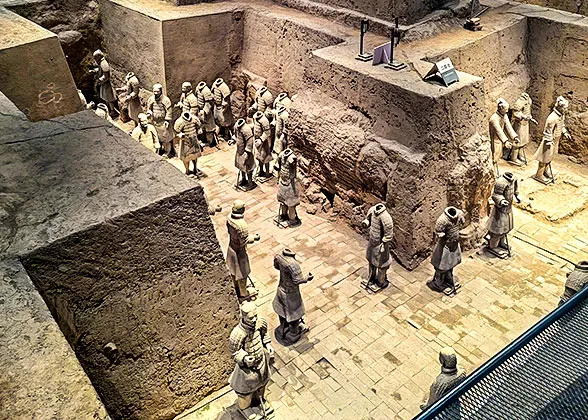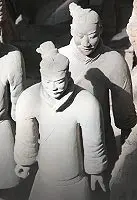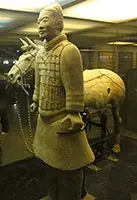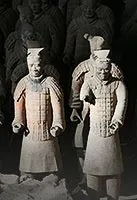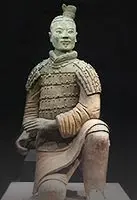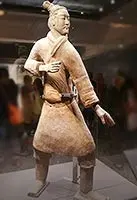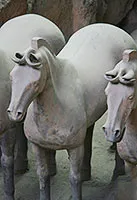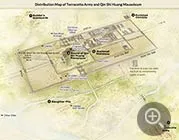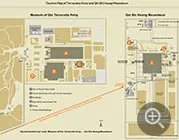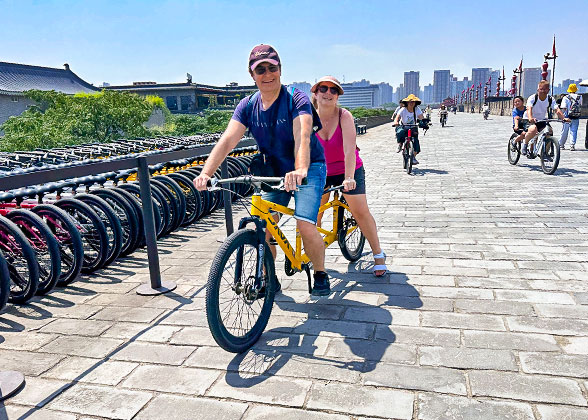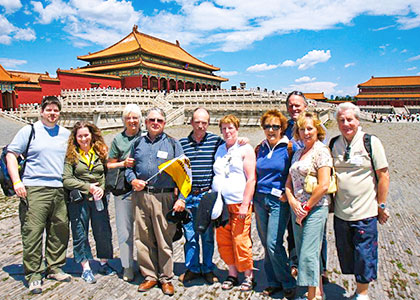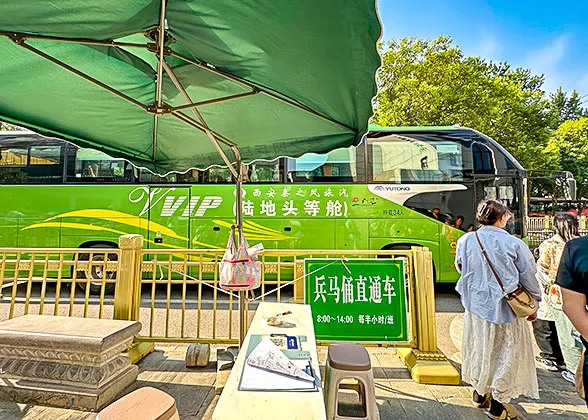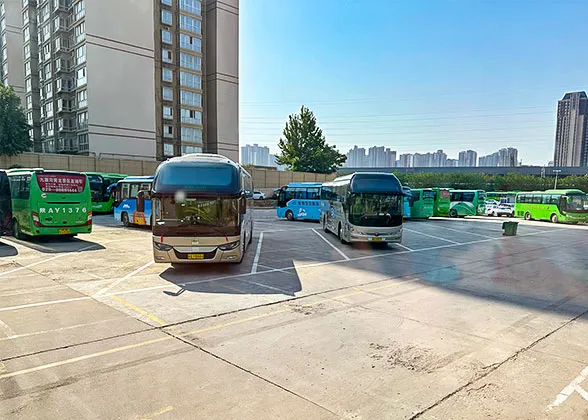Nestled within the “Emperor Qinshihuang's Mausoleum Site Museum” in Lintong District of Xi'an City, the Terracotta Army, also known as Terracotta Warriors and Horses, lies approximately an hour's drive from the city center. Constructed by
Emperor Qin Shi Huang (259 BC - 210 BC), the first emperor of a unified China, to safeguard his mausoleum, it constitutes an underground legion composed of life-sized terracotta warriors and horses. Revered as the “Eighth Wonder of the World,” it stands as one of the two remaining “Wonders of the World” and has been inscribed on the UNESCO World Heritage List.
In March 1974, Yang Zhifa and several villagers chanced upon the Terracotta Army while digging a well. These terracotta warriors and horses represent the largest and most intricate assemblage of pottery figurines in ancient Chinese history, with a legacy spanning over 2,200 years. The Mausoleum of the Qin Shi Huang encompasses a vast expanse of 56 square kilometers (22 square miles), equivalent to the size of 78
Forbidden Cities, and the Terracotta Army is merely a fraction of the numerous burial pits. Remarkably, each terracotta figure boasts a distinctive appearance. Initially, they were vibrantly painted, yet upon excavation, the surface paint layers rapidly cracked and peeled away due to environmental changes, leaving them in their current earthy gray hue.
As an iconic symbol card of ancient China's splendid civilization, the Terracotta Army has emerged as an essential destination for travelers in China, drawing hordes of domestic and international tourists annually. Here, visitors can closely observe these lifelike and imposing terracotta warriors, immersing themselves in the military prowess and craftsmanship of the
Qin Dynasty (221 BC - 207 BC).
What to See
Pit 1: The Grandest Pit with the Largest Number of Figurines
Pit 1 stands as the most expansive, earliest excavated, and best-preserved among the Terracotta Army pits. Stretching 230 meters (755 feet) from east to west and 62 meters (203 feet) from north to south, it encompasses a total area of 14,260 square meters (3.5 acres), roughly equivalent to the size of two football fields. Inside, rows of warrior figurines and terracotta horses are meticulously arranged, each crafted to the same scale as their real-life counterparts. With approximately 6,000 of these figures arrayed in a formidable square formation, the scene is both magnificent and awe-inspiring, evoking the impression of a colossal army ready to match into battle.
Pit 2: Showcasing the Greatest Diversity of Terracotta Warriors
Covering an area of around 6,000 square meters (1.5 acres), Pit 2 presents a more complex and diverse military configuration, featuring cavalry, charioteers, and infantry. It represents a mixed formation where various military units collaborate in harmony, exemplifying the multi-faceted combat capabilities of the Qin army.
Currently, the excavation of Pit 2 remains ongoing, allowing visitors the unique opportunity to witness the real-time excavation and restoration processes of the Terracotta Army. Additionally, five display cases within the pit showcase an array of figures, including kneeling archers, standing archers, cavalrymen, mid-ranking military officers, and high-ranking military officers, allowing for a detailed and up-close appreciation of the Army.
| | 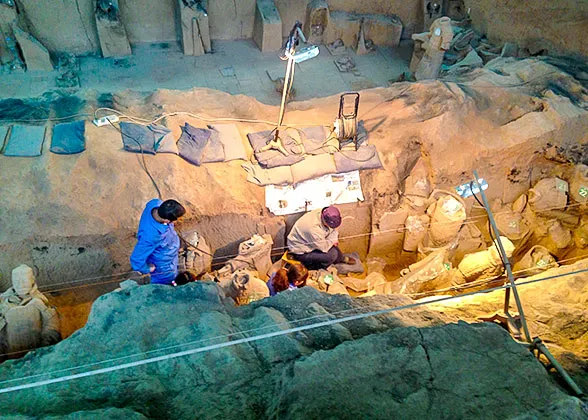 | | Archaeology Expert Excavating the Terracotta Warriors | |
Pit 3: The Command Center of the Qin Army
Pit 3, spanning approximately 520 square meters (5,600 square feet), contains 68 warrior figurines and a chariot drawn by four horses. Experts theorize that this pit likely served as the command center for the entire army. Despite its relatively compact scale, it holds a pivotal position. Notably, Pit 3 is the only pit that escaped damage by fire, resulting in the relatively well-preserved painted decorations on the terracotta warriors, which were still vivid upon excavation.
| | 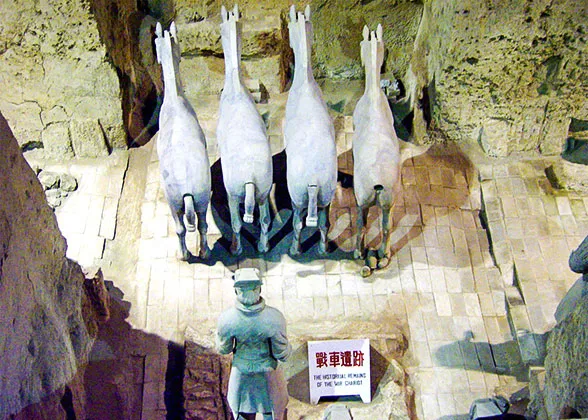 | | Horses in Pit 3 | |
-50th Anniversary Exhibition of Archaeological Discoveries at Emperor Qinshihuang's Mausoleum
Based on the archaeological excavation achievements of Emperor Qinshihuang's Mausoleum, this exhibition showcases 230 selected cultural relics that epitomize the pinnacle of excavation achievements since 1974. The exhibition offers a comprehensive and multi-dimensional portrayal of the mausoleum's appearance and significance, offering more insights into ancient Chinese funerary culture and imperial symbolism.
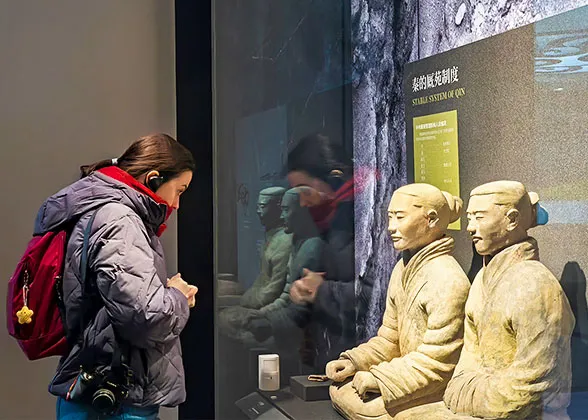 | | Cultural Relics of Emperor Qinshihuang's Mausoleum | | 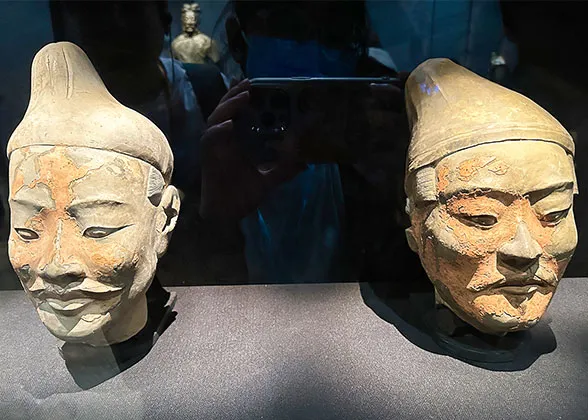 | | Color Painted Figure Head | |
Lishan Garden
The Emperor Qinshihuang's Mausoleum Site Museum also encompasses Lishan Garden, a heritage park established in the mausoleum's core area. It features three remarkable exhibition halls: Pit 9901, which displays a variety of acrobat figurines representing the imperial entertainment troupe of the Qin Dynasty; the Museum of Bronze Chariots and Horses, housing two bronze chariots and horses, renowned as the “Crown of Bronzes” and the largest and most elaborate ancient chariots and horses ever unearthed in Chinese archaeological history; and Pit 0006, exhibiting figurines of Qin Dynasty civil officials, presenting a stark contrast to the military figures in other three pits.
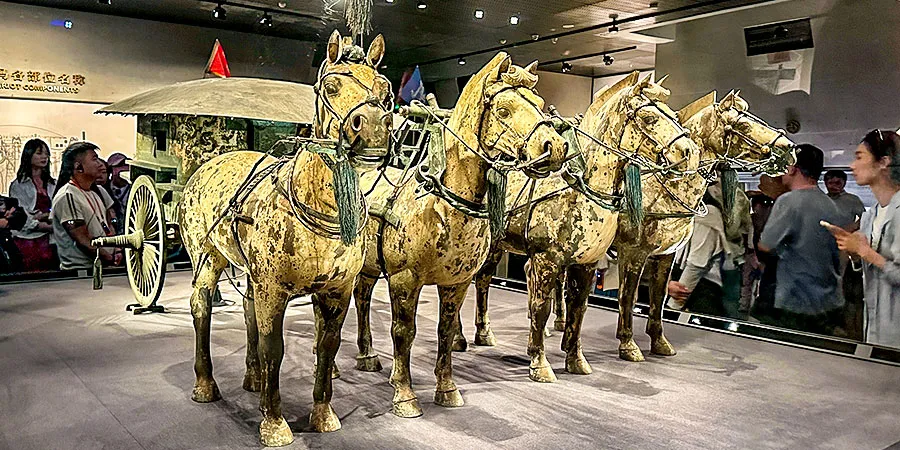 |
| Bronze Chariots and Horses |
More to see:
The Terracotta Army features eight different face shapes, 36 distinct hairstyles, and various postures, such as standing and kneeling archers. Coupled with the artisans' meticulous detailing of facial expressions, each figure is rendered with miraculous individuality, making no two alike.
More Terracotta Army Facts:
Route 1: The Popular Choice

Route: Pit 1 → Pit 3 → Pit 2 → Exhibition Hall of Cultural Relics

Duration: 2.5 - 3 hours
Pit 1: 1 - 1.5 hours
Pit 3: 30 minutes
Pit 2: 30 minutes
Exhibition Hall of Cultural Relics: 30 minutes
Upon entering the Emperor Qinshihuang's Mausoleum Site Museum, it is approximately 1 kilometer (0.6 miles) to the Terracotta Army Exhibition Area. Visitors can choose to walk or take the sightseeing bus. Then, go to explore the three pits and the exhibition hall.
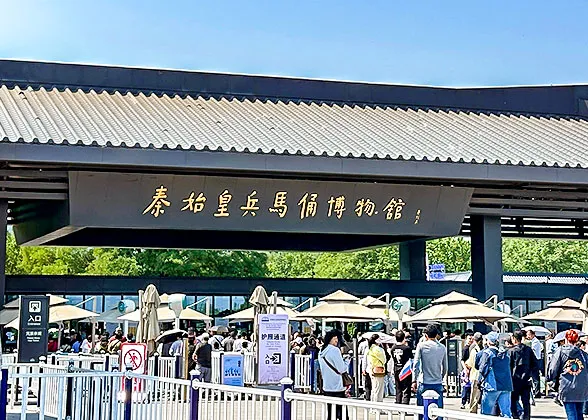 | | Entrance of the Terracotta Warriors and Horses Museum | | 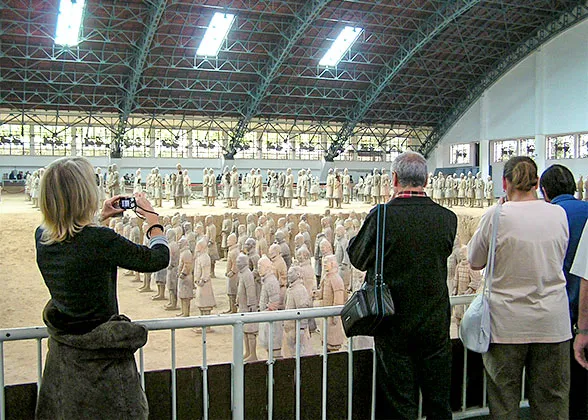 | | Tourists visiting the Terracotta Warriors | |
Route 2: In-depth Tour of the Terracotta Army

Route: Pit 1 → Pit 3 → Pit 2 → Exhibition Hall of Cultural Relics → Lishan Garden → Pit 9901 → Museum of Bronze Chariots and Horses → Pit 0006

Duration: 3 hours at the Terracotta Army + 1 hour for rest and lunch + 2 hours at Lishan Garden
After visiting the Terracotta Army, take a break for a meal and recuperate. Then, board the free shuttle bus to Lishan Garden. Upon arrival, the sightseeing bus can be utilized to visit Pit 9901, the Museum of Bronze Chariots and Horses, and Pit 0006 in sequence, a process that typically takes around 2 hours. Finally, take the shuttle bus back to the Terracotta Army exhibition area.
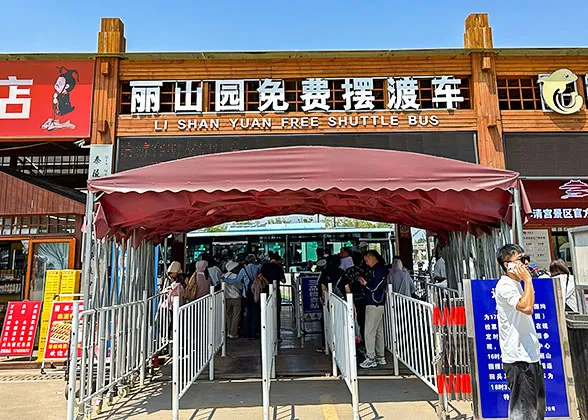 | | Shuttle Bus Station to Lishan Garden | | 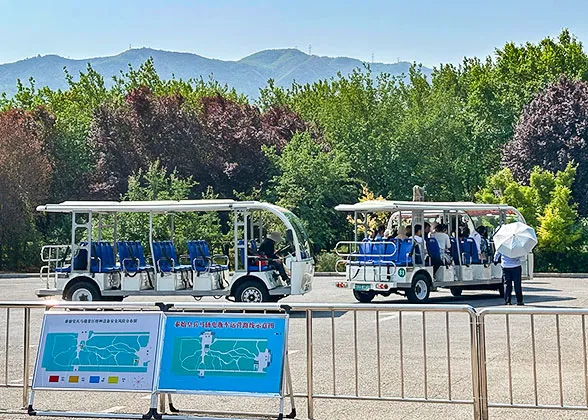 | | Sightseeing Bus, Lishan Garden | |

Tip:
For those seeking to avoid the crowds, it is advisable to visit Lishan Garden first upon arrival at the scenic area and then return to explore the Terracotta Army, thus ensuring a more tranquil and leisurely tour experience.
Opening Hours:
- March 16 - November 15: 08:30 - 18:30, last admission at 17:00.
- November 16 - March 15: 08:30 - 18:00, last admission at 16:30.
The best time to visit the Terracotta Warriors Museum is after 15:00 on weekdays, as this allows visitors to evade the bulk of the crowds and enjoy a more serene visit. It is advisable to avoid weekends and holidays if possible.
Tickets:
| Entrance Fee | CNY 120
Note: The fare includes access to both the Terracotta Warriors and Horses Museum and Lishan Garden. |
| Sightseeing Bus | Terracotta Warriors and Horses Museum: CNY 5
Lishan Garden: CNY 15 |
| Audio Guide | Rent: CNY 40 per person; Deposit: CNY 100 |
The museum releases 65,000 tickets daily. Visitors need to make a reservation seven days in advance via the official website or WeChat Official Account of the Emperor Qinshihuang's Mausoleum Site Museum. Since the ticket purchase page is not available in English, you can purchase it through a third-party travel agency.
1. By subway: 1.5 hours, around CNY 15
Take
Metro Line 1 to Fangzhicheng Station, then transfer to
Metro Line 9 to Huaqingchi Station. Exit from Exit C and board Bus No. 602 or No. 613, which will take you to the Terracotta Army in 13 or 2 stops respectively.
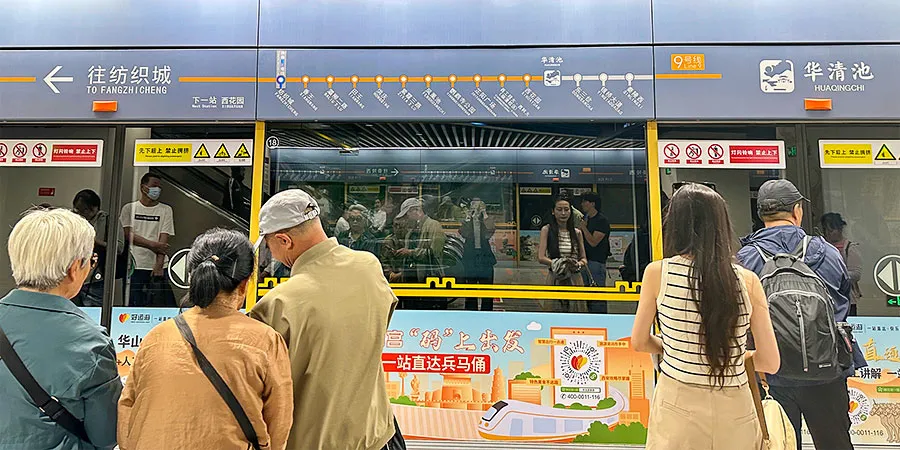 |
| Huaqingchi Station, Metro Line 9 |
2. By tourist bus: 1 hour, CNY 30 for a single-way

Boarding point:
East gate of Yisushe Grand Theater, near the
Bell TowerExit B of Sajinqiao subway station
Exit A of Shijiajie subway station
Exit C of Longshouyuan subway station

Operating hours:
To Terracotta Army: 8:00 - 12:00
From Terracotta Army: 13:00 - 18:00
3. By city bus: Bus Line You5 (306): 1.5 hours, CNY 10

Boarding point: Fangzhicheng Bus Station or East Square of Xi'an Railway Station

Operating hours:
From Fangzhicheng: 7:00 - 19:00
From Xi'an Railway Station: 7:00 - 19:00
From Terracotta Army: 08:10 - 19:00

Interval: 10 - 30 minutes
4. By taxi: 40 minutes, CNY 120 - 150
For groups of three or four people, taking a taxi offers a quicker, more economical, and more comfortable travel option.
Read more:
Tips:
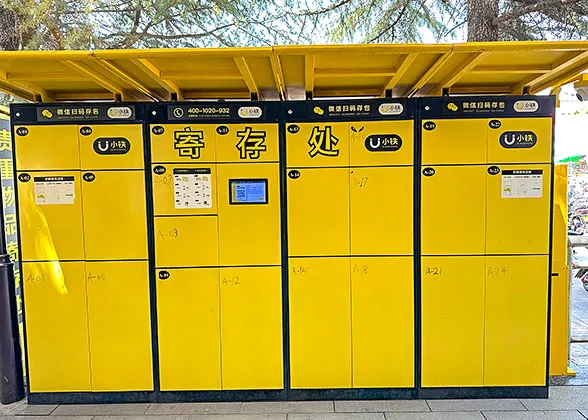 |
| Luggage Locker |
1. It is recommended to wear comfortable shoes.
2. Bringing some snacks and water to replenish energy during the visit is advisable.
3. Luggage lockers are available on the east side of the ticket center.
4. It is prudent to refrain from purchasing Lantian jade products from the stalls at the entrance, as counterfeits are prevalent.
5. Given that the allure of the Terracotta Army lies in its rich historical narrative, hiring an English-speaking guide is strongly recommended for a more enriching experience.
More tips:
Besides Xi'an, Where Else Can You See Terracotta Army?
The Terracotta Army of Emperor Qinshihuang in Xi'an is so famous that it has almost become a synonym for Terracotta Warriors. However, Terracotta Warriors are not only found in Xi'an. Currently, there are also Yangjiawan Terracotta Warriors in Xianyang City, Shizishan Terracotta Warriors in Xuzhou City, the Han Yang Ling Terracotta Warriors in Xianyang, and the Weishan Terracotta Warriors in Jinan City. Additionally, Terracotta Army figures are often exhibited abroad, and you might even see them in local museums.
More Interesting Background and Stories about the Terracotta Army
- Last updated on May. 22, 2025 by Sherry Xia -
